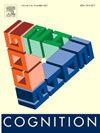Blending simulation and abstraction for physical reasoning
IF 2.8
1区 心理学
Q1 PSYCHOLOGY, EXPERIMENTAL
引用次数: 0
Abstract
How are people able to understand everyday physical events with such ease? One hypothesis suggests people use an approximate probabilistic simulation of the world. A contrasting hypothesis is that people use a collection of abstractions or features. While it has been noted that the two hypotheses explain complementary aspects of physical reasoning, there has yet to be a model of how these two modes of reasoning can be used together. We develop a “blended model” that synthesizes the two hypotheses: under certain conditions, simulation is replaced by a visuo-spatial abstraction (linear path projection). This abstraction purchases efficiency at the cost of fidelity, and the blended model predicts that people will make systematic errors whenever the conditions for applying the abstraction are met. We tested this prediction in two experiments where participants made judgments about whether a falling ball will contact a target. First, we show that response times are longer when straight-line paths are unavailable, even when simulation time is held fixed, arguing against a pure-simulation model (Experiment 1). Second, we show that people incorrectly judge the trajectory of the ball in a manner consistent with linear path projection (Experiment 2). We conclude that people have access to a flexible mental physics engine, but adaptively invoke more efficient abstractions when they are useful.
融合模拟和抽象,促进物理推理
人们为什么能够如此轻松地理解日常物理事件?一种假设认为,人们使用的是对世界的近似概率模拟。与之相反的假设则认为,人们使用的是一系列抽象概念或特征。虽然人们注意到这两种假设可以解释物理推理的互补性,但还没有一个模型可以说明这两种推理模式如何结合使用。我们开发了一种 "混合模型",它综合了这两种假设:在某些条件下,模拟被视觉空间抽象(线性路径投影)所取代。这种抽象以逼真度为代价来提高效率,混合模型预测,只要满足应用抽象的条件,人们就会犯系统性错误。我们在两个实验中测试了这一预测,实验中参与者对下落的球是否会接触目标做出判断。首先,我们表明,当直线路径不可用时,即使模拟时间保持不变,人们的反应时间也会更长,这与纯模拟模型相悖(实验 1)。其次,我们证明了人们以符合直线路径投射的方式错误地判断了球的轨迹(实验 2)。我们的结论是,人们可以使用灵活的心理物理引擎,但在有用时会自适应地调用更有效的抽象概念。
本文章由计算机程序翻译,如有差异,请以英文原文为准。
求助全文
约1分钟内获得全文
求助全文
来源期刊

Cognition
PSYCHOLOGY, EXPERIMENTAL-
CiteScore
6.40
自引率
5.90%
发文量
283
期刊介绍:
Cognition is an international journal that publishes theoretical and experimental papers on the study of the mind. It covers a wide variety of subjects concerning all the different aspects of cognition, ranging from biological and experimental studies to formal analysis. Contributions from the fields of psychology, neuroscience, linguistics, computer science, mathematics, ethology and philosophy are welcome in this journal provided that they have some bearing on the functioning of the mind. In addition, the journal serves as a forum for discussion of social and political aspects of cognitive science.
 求助内容:
求助内容: 应助结果提醒方式:
应助结果提醒方式:


